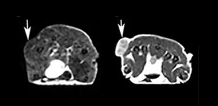New low-dose MRI contrast agent distinguishes aggressive breast cancers from slow-growers
In mice, combined agent provides higher contrast in MRI images of aggressive cancers

The right image shows how much brighter a triple-negative tumor (aggressive) looks with ZD2-Gd3N@C80, as opposed to (left) an ER-positive breast cancer tumor (slow-growing.)
NIBIB-funded researchers at Case Western Reserve University have developed a new imaging contrast agent that can detect breast cancer and could give doctors an indication of the potential aggressiveness of the cancer. The key to developing the new contrast agent was taking a commercially available form of gadolinium, Gd3N@C80, and adding a peptide, ZD2, that specifically targets a cancer protein more prevalent in aggressive cancer types. Gd3N@C80 uses 20-times less gadolinium than standard contrast agents due to its higher efficacy. The new targeted agent also is expected to be safer than the existing agents because the gadolinium is completely encased in fullerene, a sphere of carbon, which prevents it from interacting with or being absorbed by any tissue. Zheng-Rong Lu, Ph.D., M. Frank Rudy and Margaret Domiter Rudy Professor of Biomedical Engineering at Case Western Reserve University, and his team found that when combined with the ZD2 peptide, the resulting contrast agent enabled researchers to clearly visualize the difference between aggressive (triple-negative) and slow-growing (ER-positive) tumors.
The lab tested three aggressive and three slow-growing breast cancer types. Using a conventional contrast agent, the six tumors would be indistinguishable from one another; however, Lu and his team found that with the new combined agent, they could determine which three tumors were aggressive simply by looking at the MRI images. This targeted contrast agent could one day be an additional tool in a doctor’s arsenal when determining the best course of treatment for patients.
Program Area:
Health Terms:
Breast Cancer,
MRI






















.png)











No hay comentarios:
Publicar un comentario